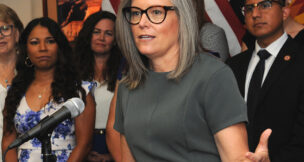AZ historian, ‘Times Past’ writer passes away
Williams Lane Rogers was born Dec. 29, 1944, in Salt Lake City. The 30-year Arizona resident chose to go by "Lane" because there was already a somewhat-famous "Will" Rogers in the world. Rogers, who died July 30 at the age of 64, would leave his own lasting impression on those who knew him, starting with a 23-year-old girl responding to a job ad in 1977.
Arizona’s glittering silver inkwell
Colonel Charles D. Poston, self-named "Father of Arizona," commissioned the opulent treasure while serving as Arizona Territory's first delegate to Congress. He presented it to the president in March 1865, as a gift of appreciation for splitting New Mexico Territory in half to create Arizona in 1863.
Mine with the iron door
"Look for the mine with the iron door, Jimmy," my dad said. When I was about six years old, Dad told me the legend of the lost mine and the Spanish missionaries who mined silver and gold on the north side of the Catalina Mountains. We'd leave Tucson in the dark to hunt quail on Golder Ranch, Owl's Head, or Tecolote northwest of town....
Globe Masons
In 1879, six men met in Globe, Ariz., to discuss leaving their respective Masonic temples. Their first task was to figure out if enough of them were actually willing to dimit (a Masonic term used for a written certification of honorable withdrawal from membership) from their respective lodges to establish a new lodge of Free & Accepted Masons in the small town east of Mesa.
The curious death of the ‘Father of Arizona’
Charles D. Poston was born in Hardin County Kentucky on April 20, 1825. At age 12, he was apprenticed to the County Clerk's Office for seven years, after which he studied law and was admitted to the Bar.
Naming Arizona
The 1873 and 1876 migrations into Arizona Territory by the Church of Latter-day Saints (LDS) primarily followed the wildly fluctuating course of the Little Colorado River. Town sites initially established at river's edge were often washed out, which caused settlers to move to higher ground. The settlers usually located at sites that were already occupied by others, and today's names of these locat[...]
Never mind Mining
This 1956 photo of Tombstone shows a modern, but economically depressed town. It wasn't until Hollywood painted a fantastic picture of the Wild West did the town cash in its rough-and-tumble lore with tourists.
Triangle L Ranch
Triangle L Ranch, one of the first dude ranches in southern Arizona, began in the 1890s as a working cattle ranch frequented by Buffalo Bill. The 49-acre property near the Catalina Mountains is now operated by Sharon Holnback as a bed-and-breakfast, farmers' market, art gallery and concert venue, but once had its share of horse opera drama.
A legendary craftsman
In 1919, El Tucsonense, Arizona's largest Spanish language newspaper, hailed Federico Ronstadt as "one of the most prominent figures in the higher commercial circles of Tucson." The writer did not exaggerate.
Famous names in Arizona: LDS settlers and the Colorado
The Church of Jesus Christ of Latter-day Saints (LDS) President Brigham Young’s vision of settling the West that began in the 1850s initially met with little success.
The Southern Arizona Auto Company
The Stevens-Duryea Company produced cars in Chicopee Falls, Mass., between 1901 and 1915 and from 1919 to 1927. The company’s first foray into the car business began with the introduction of a two-cylinder, five-horsepower runabout that sold for $1,200. The firm produced 61 cars in 1902 and 483 in 1903.
A Superior destination
While Lake Superior is far from Superior, Ariz., the miners who came to explore the mountains in what is now Pinal County honed their skills in the Great Lakes region before mines there played out and they heard of new opportunities in the West.






